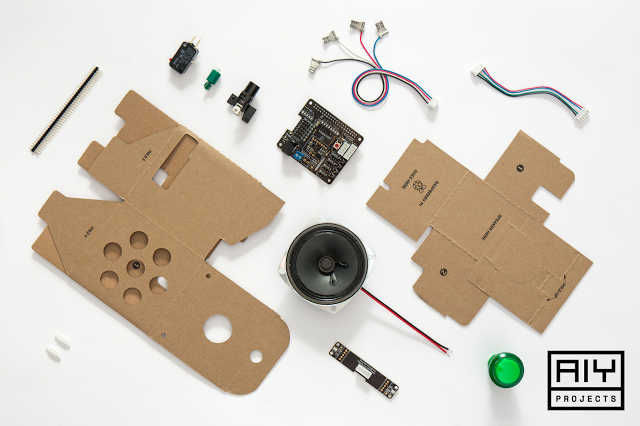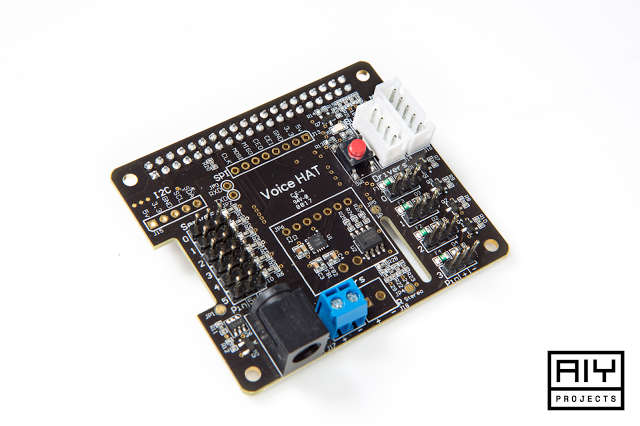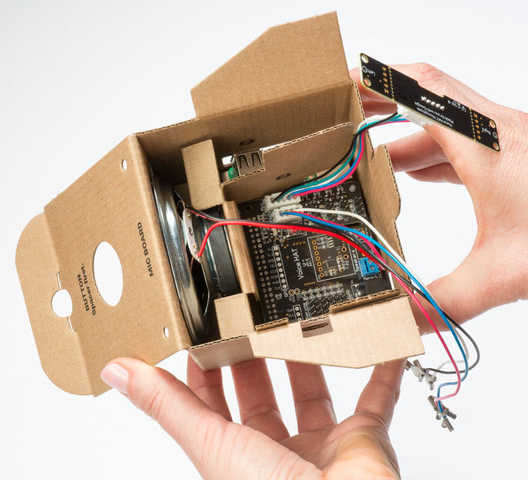| Google AIY Cardboard And Raspberry Pi AI |
| Written by Harry Fairhead | |||
| Monday, 08 May 2017 | |||
|
Google has promised to create a number of "reference" kits bringing AI to the masses - called AIY like DIY but for AI. The first is the Voice Kit designed to do the same sort of job as Amazon's Alexa, but using cardboard, sticky tape and a Raspberry Pi.
OK I might have emphasised the sticky tape just to make it sound more like a hacked together project, but what is it with Google and cardboard?! This particular kit is an add-on board, a HAT, for the Raspberry Pi 3. What you get in the kit is:
You have to supply the Pi 3, an SD card, screwdriver and, oh yes, the sticky tape. Putting it together is a matter of mounting the HAT, microphone and speaker and then folding up the cardboard case. Next you download some software that has been prepared for you and boot the Pi. It should just work and you can tell it is by the flashing LED on the top of the cardboard box.
Now the real work starts. The thing that probably strikes most casual onlookers is the hardware and that cute cardboard cutout, but this really isn't about hardware. The core of the project is about using Google's natural language recognizer and Google Assistant. Using the Google Assistant SDK you can build some interesting things. Of course, to do this you will have to sign in to the Google Cloud Platform where the Assistant SDK is free for personal use. Getting setup means getting up close and personal with the Google Cloud Platform, the dashboard and its facilities. It isn't difficult, but it isn't a one-step solution either. Once you have the basic speech recognition and the Google Assistant sorted out, it's time to think of new things to do with it. To go further you need to change to the cloud speech API which is free for the first 60 minutes of voice per month and then $0.006 per 16 seconds. You will need to supply a credit card and enable billing.
Now here is the really good news. Unlike Alexa it seems that you can install your own apps and program your own actions triggered by voice commands. You can simply write a Python program, say, and add it to the action.py file to link what the user has to say to the program that will run. It also seems that you can arrange to control other apps that you have installed, so you could make your own voice controlled music player. The Google documentation makes a lot of being able to run Google Things, its Android based IoT app. Given my current opinion of Google Things I think I'd stick with Python. At this point you probably want one - I know I do - and here is the bad news. The kit was given away attached to the cover of MagPi, the magazine printed by the Raspberry Pi foundation, which should mean you can have the hardware, including the cardboard case, for just £6 or roughly $8. Sounds good, but of course they are all sold out. The documentation suggests that you might be able to get some from Barnes and Noble of all places, but you're out of luck there too. What is it with the Raspberry Pi that makes sticking things on the cover of a paper magazine so attractive. They gave away the first Pi Zeros as cover mounts and they been in short supply ever since - guess that's the fate of the Voice Kit. So great fun and we will have to look forward to future AIY kits. I hope the build your own HAL, or even Alpha Go, is available very soon and not out of stock. In the meantime all you can do is add your name to a list to be informed when there is some stock. This is no way to run a railroad.
More InformationAIY Projects: Do-it-yourself AI for Makers Related ArticlesAndroid Things Dev Preview 2 Could Be What We Need! Getting Started With Google's Android Things - Preview 2
To be informed about new articles on I Programmer, sign up for our weekly newsletter, subscribe to the RSS feed and follow us on Twitter, Facebook or Linkedin.
Comments
or email your comment to: comments@i-programmer.info |
|||
| Last Updated ( Monday, 08 May 2017 ) |





